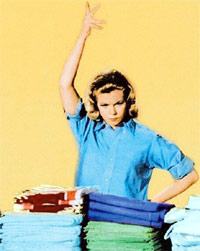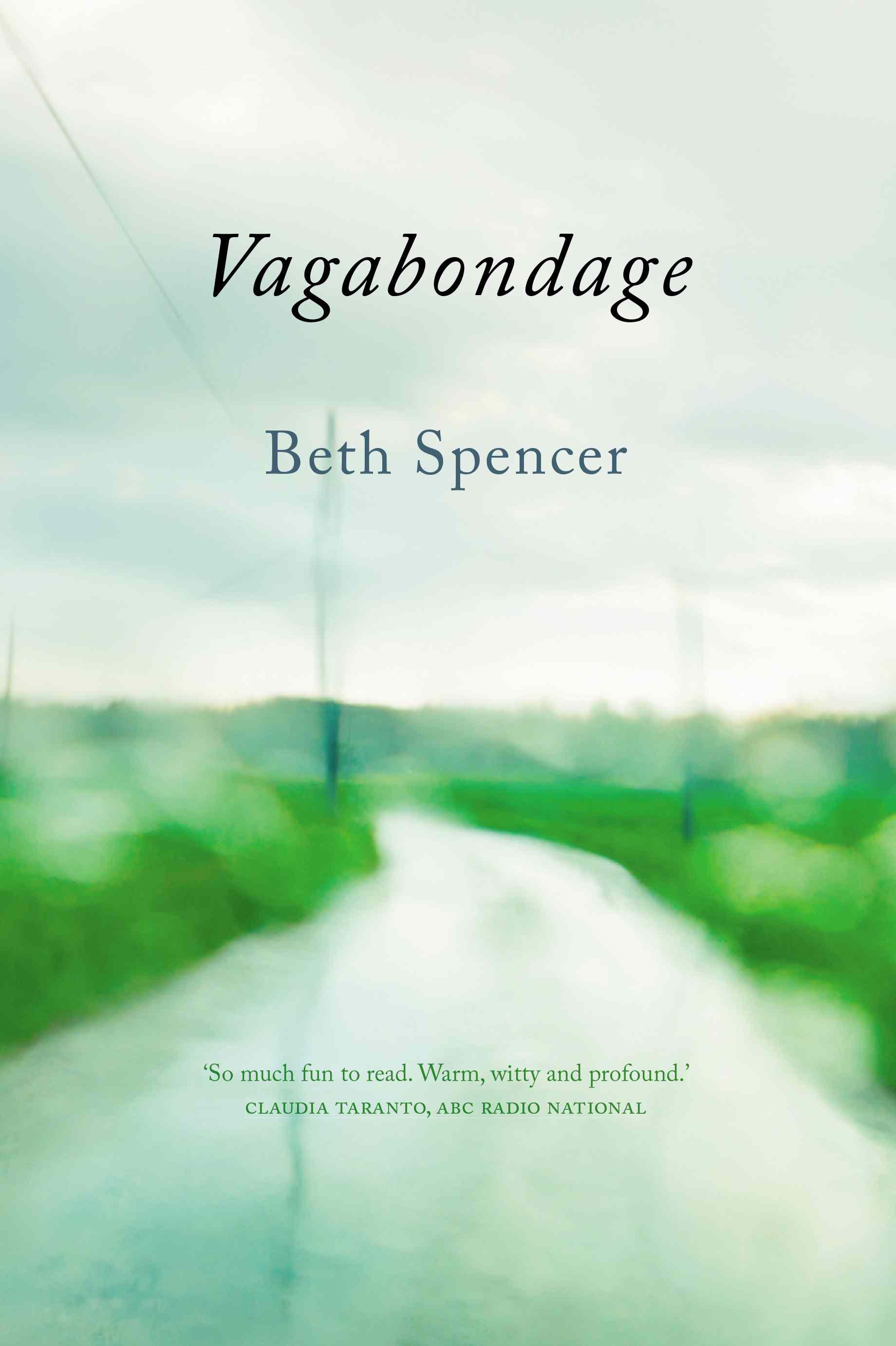Friends came and stayed for a week recently and bought me a TV. This is the first time I’ve had a tv set for over 18 months. I hadn’t really missed it, but now of course I’m addicted again. So, with Bewitched back on prime time where it belongs, I thought I’d post a (slightly revised version) of piece I wrote for the Age a few years back, originally titled ‘Samantha, Every Witch Way But Lose’.

The Bewitched tv series, with the gorgeous Elizabeth Montgomery as Samantha Stephens, the nose-twitching witch from 1164 Morning Glory Circle, began casting its magic in Australian homes from the mid 1960s.
Back then, instead of the News theme, in our house it was the Bewitched theme that signalled six o’clock — the witching half-hour — as the animated-Samantha flew in on her broomstick (demurely side-saddle), burnt the dinner, turned into a cat, and jumped seductively into Darrin’s arms.
On the surface, Bewitched was a tale of romantic love – a woman choosing to give up her independence and career for the supreme fulfilment of being a wife and homemaker. They had a beautiful house, all the latest mod cons, a respectable neighbourhood, and the cold war McCarthy years were behind them. It was John Howard’s suburban dream of yester-year — all that was missing was the white picket fence.
But the way in which the series both played into and subverted a rich lode of cultural stereotypes and allusions was set from the very first episode. Darrin, having just discovered Sam’s secret, moans drunkenly to the bartender, ‘What do you do when you find out your wife is a witch?’ And the bartender replies, ‘Well, you just have to learn to live with it. We all do.’
‘No, no,’ says Darrin, ‘My wife really is a witch.’
‘Ha.’ Says the bartender. ‘You should see my wife’Casting a witch as a beautiful, clever, desirable young woman (well, young in witchy terms – only 3000 years old) opened a cascading set of boxes filled with some of our deepest wishes and fears, at the same time as it created the perfect brew for a successful sit-com.
On the one hand, it’s the ultimate 60s-male fantasy of a woman who is enchanting, strong and powerful, but would give it all up for love. And on the other, it’s the suburban nightmare — the hapless man surrounded by mysterious, unpredictable creatures who have abilities beyond his imagination (even the mortal ones can birth babies and feed them milk out of their breasts!). As Darrin struggles to be king of his castle, his in-laws can’t even be bothered to get his name right — Endora calls him Durwood; Maurice thinks his name is Duncan; and Serena just refers to him as ‘What’s-his-name’.
Like any dream-nightmare it’s full of jokes and puns and word play. The unconscious drawing on everything at hand – vaudeville, myth, history, literature, as well as the many social issues of the day. So Endora arrives as fifty years of mother-in-law jokes come home to roost on the kitchen countertop; while poor Aunt Clara ends up with a Roman emperor in the kitchen when she tries to assemble a salad; and Serena wears a peace-symbol in amongst her jewellry.
Launched in 1964, a year after the assassination of JFK, the historic Civil Rights march on Washington, and the publication of Betty Friedan’s The Feminine Mystique, the series gave a new spin to the idea of a ‘mixed marriage’, and well-and-truly reclaimed witch power from the old hag image.
For if there was a hag in the show it was Gladys Kravitz, the busy-body neighbour over the road – bored, fatuous, sexless, and dull – the product of years of good wife-ism; a constant reminder to Darrin to be careful what he wished for.
As an eight year old, lying stretched out in front of the television on our green wall to wall carpet, with the fler lounge and the glass sliding doors into the kitchen where my mother would repeatedly call to us girls (but not the boys) to come and set the table, it was obvious that this was light years away from the pipe-smoking all-knowing patriarchy of My Three Sons and Father Knows Best.
Father knows best? Now there’s a fantasy.
In fact you could say that Bewitched portrayed a world of competing fantasies: as an advertising executive, Darrin too was in the business of casting spells. And although it was always abundantly clear who was the real creative genius here, it was imperative that Sam be persuaded to hang up her broomstick in favour of a vacuum cleaner (latest model, of course), and trade in her wizardry for a kitchen whiz.
For while it was never explained whether the materialised goodies were transported from elsewhere or created with a kind of witch-nanotechnology, as long as Sam continued to twitch her nose and conjure up whatever she needed by herself she was a threat to the entire capitalist-consumerist world that Darrin represented and from which he made the living which earned him the role of household head.
In this world of middle-class mortals, Sam was always suffering mysterious ailments. Like the episode where each time she sneezes a bicycle, or tricycle, even a penny-farthing, appears out of nowhere. ‘Totally logical,’ announces Dr Bombay (the family witch-doctor) once he’s summoned, ‘In fact it’s cycle-logical.’
Or the time everything she touches turns to gold: ‘a guilt complex’. And the morning she wakes up to find the doors and windows sealed against her — spelling out what it is to be a housewife trapped in a house. The diagnosis (Dr Bombay twirls his moustache): the house has developed a vapour-lock because she’s been suppressing her natural powers. The solution: start using them.
It was definitely a fable for our time: a weird handbook showing all the contortions and tricks required to keep that happy home thing functioning, and to keep the man feeling head of the house. (I could almost hear my mother’s voice in my ear: See, you can’t have love and a career.)
And while it might have been hard at times to choose to be Samantha if that meant never being Serena, choosing between ending up as Phyllis Stephens (or Gladys Kravitch) and ending up as Endora was no contest.
I also didn’t want to end up as Sam (elected to post of Queen of the Witches in 1968!) flinching from Darrin’s anger whenever things went wrong. ‘ We-ll’ she’d coax, cringing away from the ever-present threat of violence just below the surface of his love (while the laugh track carried on). But what do you expect if you agree to give up all your powers?
To Endora and the other witches, Sam was a tragically fallen woman – a drudge to a man. Borrowing from the perennial struggle between the good girls and their dark undersides that runs deep throughout American literary history, this Fair Maiden had, of course, to have her Dark Lady: who arrived in the form of her gerrrooovay micro-mini-skirted identical-cousin Serena. Listed in the credits as Pandora Spocks (Elizabeth Montgomery’s idea), she was indeed trouble.
Witches have traditionally been regarded as sexually subversive and dangerous, and Serena was the swinging sixties playgirl to the hilt. A good-time girl to Samantha’s good girl. So when Sam was mysteriously pestered by an old bedwarmer that kept floating off the wall of an historic house she was visiting in Salem, it didn’t take her long to twig that this might have something to do with Serena. Summoned from a party somewhere in the Galaxy, Serena identifies it as an old lover. Serena is always very literal: when she grew tired of him, well she just changed him into exactly what he was to her. (Likewise in another episode, a guy croons into her ear on the dance floor, ‘Fly me to the moon’ – and the next moment, there he is, looking into a crater.)
Watching it, I never identified with the mortals (who could?). That was part of its magic: for half an hour once a week you got to identify with a long buried wiccan heritage — an other way of being, which men could be a part of too, but in which the feminine was supreme. The feminine, the queer, the magical – the irruption of the repressed right into our lounge-room every week (rated G).
Bewitched was inspired in part by two earlier movies – the 1942 I Married a Witch; and Bell, Book and Candle from 1958, starring Kim Novak, James Stewart and Jack Lemmon. But it worked beautifully as a sit-com — no happy-ever-afters, just yet-another temporary truce between turbulent episodes.
Which is why I had my doubts that the concept suited being snipped to fit the contemporary romantic comedy genre — that brand of woo that they brew in Hollywood these days.
I shuddered to think what kind of final scene they’d conjure with all the mortals and all the witches and warlocks coming together in the cliched cheering and clapping – a happy homogenisation.‘We are quicksilver,’ said Endora to Samantha, ‘a fleeting shadow, a distant sound. Our home has no boundaries beyond which we cannot pass. We live in music, in a flash of color. We live on the wind, and in the sparkle of a star.’
And you can bet your sweet broomstick on that.
*
This piece was first published as ‘Samantha, Every Witch Way But Lose’
in the (Melbourne) Age, 25th June 2005, to coincide with the release of the film version starring Nicole Kidman and Will Ferrell. I decided to give the movie a miss, and still haven’t seen it. What do you reckon? Magic, or a fizzer?
*
Love to get your comments or memories about Bewitched, and please do use the share button below if you think your FB friends or twitter followers might be interested.
For more about Bewitched visit









![[The Party of Life, cover]](http://bethspencer.com/blog/wp-content/uploads/2012/11/sm-edged-front-cover-Party-of-life-227x300.jpg)


10 Responses to Bewitched, TV, Women and the 1960s — jokes, magic, dreams & gender politics